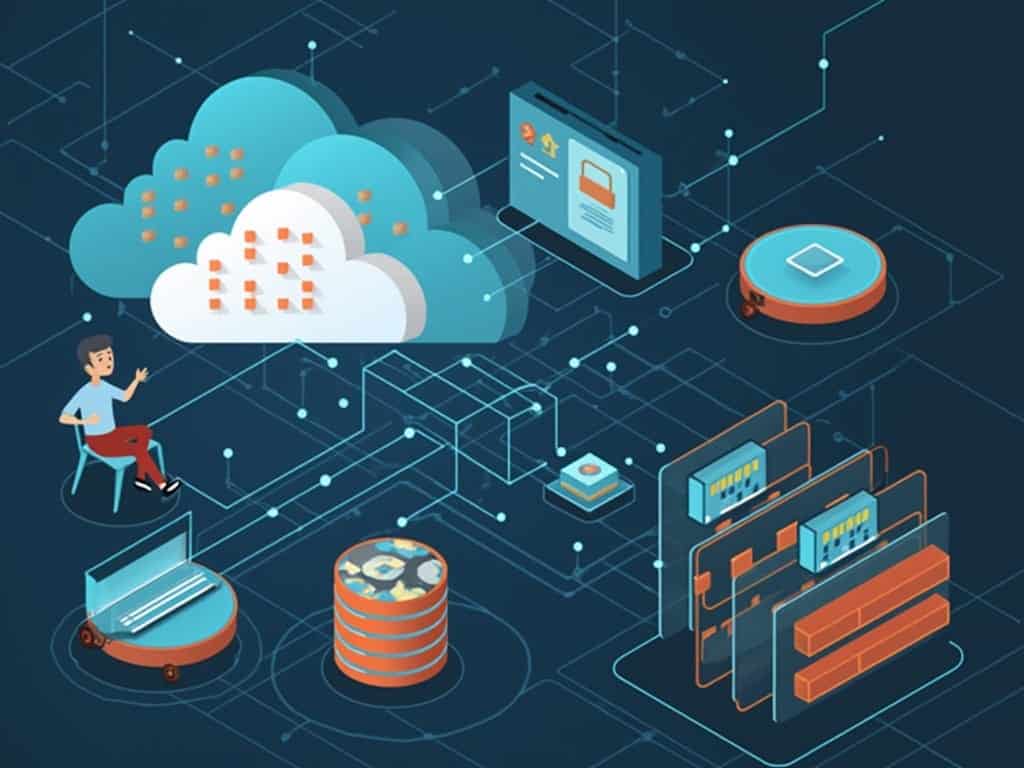Platform-as-a-Service (PaaS) delivers a complete cloud-based development system that lets developers channel their energy into building and launching applications. I’ve found that PaaS eliminates infrastructure hassles by packaging development tools, databases, and middleware into one streamlined solution. My research indicates this approach cuts development cycles by up to 50% versus standard methods through automated scaling and continuous updates.
Key Takeaways:
- PaaS brings together essential development resources – from coding tools to databases and middleware – in a single platform that handles infrastructure automatically
- Switch to a pay-as-you-go structure to remove initial infrastructure investments and slash operating costs by 40-60%
- Security comes standard with automatic updates, strong encryption, and advanced firewall protection
- Quick deployment paths support multiple coding languages while connecting smoothly with external services
- Companies must address potential vendor dependency and performance needs, but container technology and backup systems offer practical solutions
PaaS Explained: The Essential Guide to Platform-as-a-Service
Core Components and Benefits
Platform-as-a-Service (PaaS) stands as a cloud computing model that delivers a complete development environment without the need to manage underlying infrastructure. I find PaaS particularly valuable for developers who want to focus on creating and deploying applications rather than handling server maintenance.
The platform includes these essential elements:
- Development tools, servers, and databases
- Storage systems and networking infrastructure
- Middleware for seamless application integration
- Operating systems and runtime environments
PaaS fits between Infrastructure-as-a-Service (IaaS) and Software-as-a-Service (SaaS) in the cloud spectrum. Major providers like Microsoft Azure and Google Cloud have made PaaS accessible to organizations of all sizes.
Using PaaS can cut development time by 50% compared to traditional methods, according to Microsoft Azure case studies. The cost benefits are significant – businesses don’t need to purchase or maintain physical servers and development tools. Instead, they pay for what they use through a subscription model.
The platform handles automatic scaling, security patches, and updates, letting developers concentrate on writing code. This makes PaaS an ideal choice for teams building web applications, APIs, or microservices. Modern PaaS solutions support multiple programming languages and frameworks, giving developers flexibility in their technical choices.
How PaaS Works: Core Components and Architecture
Essential Building Blocks
PaaS combines multiple development tools into a unified platform. I’ve found that integrated development environments (IDEs) sit at the forefront, letting developers write, test, and debug code efficiently. Version control systems track changes and enable team collaboration.
The platform offers these key components:
- Middleware services managing communication between applications
- Database management systems handling data storage and retrieval
- Infrastructure components including servers and storage
- Multiple programming language support with pre-built frameworks
- APIs for third-party service integration
Google App Engine demonstrates this structure by providing Python, Java, and Go environments, while Microsoft Azure offers extensive .NET integration. IBM Cloud Foundry takes a flexible approach, supporting multiple programming languages through buildpacks that automatically configure the runtime environment. These services run on distributed systems that scale automatically based on demand.

Business Benefits and ROI of PaaS
Cost and Efficiency Gains
PaaS delivers significant financial advantages through its pay-as-you-go model, eliminating upfront infrastructure costs. I’ve seen companies cut operational expenses by 40-60% by removing the need for physical servers and maintenance staff.
Here’s how PaaS creates value for businesses:
- Automated management reduces IT admin costs by handling updates, security, and maintenance
- Quick scaling lets you pay only for resources you use
- Built-in development tools speed up application deployment
- No capital expenses for hardware or data centers
- Development teams can focus on code instead of infrastructure management
The platform handles resource allocation automatically, which means your applications can scale instantly during traffic spikes without manual intervention. This combination of financial flexibility and technical efficiency makes PaaS an attractive option for organizations aiming to maximize their technology investments while maintaining agile operations.
Security and Operations Management
Built-in Security and Monitoring Tools
PaaS platforms include essential security features that protect applications and data automatically. I recommend leveraging the comprehensive firewall management systems that shield against common cyber threats while maintaining application performance. Advanced encryption protocols secure data both in transit and at rest, complemented by authentication mechanisms that control user access.
These key security tools make application management more straightforward:
- Automated security updates that patch vulnerabilities without manual intervention
- Performance monitoring dashboards tracking response times and error rates
- Resource usage analytics that highlight optimization opportunities
- Built-in integration options for existing security frameworks
The automated patch management system keeps your infrastructure current with the latest security fixes, reducing the risk of breaches through outdated software. Real-time monitoring tools alert you to potential issues before they impact users, while resource tracking helps maintain optimal performance levels.
Security management in PaaS operates continuously in the background, letting you focus on application development rather than infrastructure maintenance. The built-in tools streamline operations by automating routine security tasks and providing clear visibility into application performance. This automated approach to security and operations reduces human error while maintaining consistent protection levels across your application infrastructure.
Deployment and Integration Capabilities
Streamlined Application Management
PaaS platforms excel at simplifying application hosting through automated deployment pipelines. I’ve found that modern PaaS solutions support multiple programming languages including Java, Python, Ruby, and Node.js, letting developers code in their preferred environment.
The integration capabilities of PaaS platforms make development more efficient through these key features:
- Automatic scaling that adjusts resources based on traffic demands
- Built-in load balancing to distribute requests across servers
- Database integration tools for popular options like MySQL and MongoDB
- Container orchestration for microservices architecture
- Version control system connections with Git repositories
- CI/CD pipeline automation for faster releases
PaaS environments connect smoothly with third-party services through API management tools. This allows teams to integrate essential services like payment gateways, email delivery systems, and monitoring tools without manual configuration.
Development workflows benefit from built-in testing environments, staging areas, and production deployment options. I recommend using these features to create consistent deployment processes across your team. The automated nature of PaaS deployments reduces human error and speeds up release cycles.
By handling infrastructure management automatically, PaaS lets developers focus on writing code rather than server maintenance. This approach saves time while maintaining reliable performance standards for your applications.

Implementation Challenges and Solutions
Core Infrastructure Risks
Vendor lock-in poses a significant challenge in PaaS adoption. I recommend maintaining portable application code and using container technologies to reduce dependency on specific vendors. Migration between platforms requires careful planning – standardized APIs and microservices architecture can streamline this process.
Performance and Security Management
Performance issues during outages demand proactive solutions. Here are critical strategies to maintain service continuity:
- Implement automated failover systems
- Create geographic redundancy across multiple zones
- Set up real-time monitoring and alerts
- Develop comprehensive backup procedures
- Deploy hybrid cloud configurations for critical workloads
Security remains paramount in PaaS environments. Multi-factor authentication, encryption at rest and in transit, and regular security audits form the foundation of a strong security posture. Regular penetration testing identifies vulnerabilities before they can be exploited. Hybrid cloud setups offer additional security layers by keeping sensitive data on-premises while leveraging PaaS benefits for other operations.

Sources:
Microsoft Azure
Google Cloud
Google App Engine
Microsoft Azure
IBM Cloud Foundry
DigitalOcean – “What is PaaS”
Oracle – “What is PaaS”
IBM – “PaaS”
Spot.io – “PaaS Security Threats, Solutions and Best Practices”
Enreach – “Understanding PaaS: Your Essential Guide to Platform-as-a-Service”
Related Posts

IT Vendor Management: Ensuring Efficiency and Compliance
IT vendor management demands careful partner selection, performance tracking, and relationship building to maximize value while reducing costs and risks. Through calculated selection methods, defined

Cloud Service Management: Optimizing Efficiency and Reliability
Cloud service management has transformed into a powerful system covering IaaS, PaaS, and SaaS models. AWS dominates the market with 32% share, while Google Cloud

Addressing Compliance Challenges with Managed Services
In today’s business landscape, compliance with regulatory standards is not just a recommendation—it’s a necessity. Businesses across industries face a myriad of compliance regulations, each with its own set of requirements and implications. From protecting customer data to ensuring financial transparency, compliance regulations like GDPR, HIPAA, PCI DSS, NIST, and ISO27001
